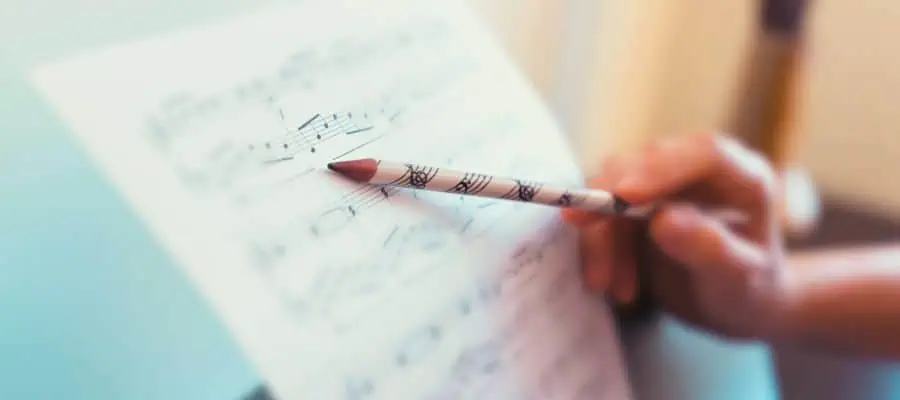If you plan on picking up a guitar, you’ll want to know how difficult it is to learn to read sheet music. While you can try playing by ear, you’ll be able to learn more songs if you can read the music.
Reading sheet music is relatively easy but is quite time-intensive. The learning process is pretty similar to learning another language. So, consistent, focussed, daily practice is the best way to take.
While you don’t need to learn to read sheet music to be a great guitarist, as names like Jimi Hendrix, Eric Clapton, Stevie Ray Vaughn, Eddie Van Halen, and many more don’t know it, you need to learn to read music if you want to take the academic way or get deeper in music theory.
In this article, I included how difficult it is to learn to read guitar music and why you should or should not take the time to learn it. Let’s begin!
Reading Guitar Sheet Music Isn’t Too Hard

Learning to read the sheet music may initially feel confusing and challenging. You may feel lost and exhausted, just like your first few attempts when learning to speak a new language. Here, the golden rule is to stay consistent, be patient, and avoid setting fixed learning timelines.
The keys to this journey are working steadily, going slowly, step by step, and giving yourself and your brain enough time to absorb the new information and habits you are learning.
The process gets much easier after you practice the notes on your guitar as you read them. You’ll start associating the notes with specific fingerings on the guitar.
Once you start forming those associations, the difficulty drops quite a bit. I recommend playing with a metronome to help you learn to stay in rhythm. You can slow the beat down, then raise it to the correct speed as you learn the music. It’s a good habit to form early on.
Although, reading guitar music is pretty easy if you already play another instrument. You will need to learn to associate the notes with new fingerings on the guitar, but you’re already more than halfway there.
As you learn to read the sheet music, you’ll form connections in your brain with how you play the notes on the guitar. Eventually, you won’t have to think about reading the notes as much, and you’ll form muscle memories with the strings.
Do not get scared of this complex process, as it is not that challenging. As mentioned before, this journey is time-intensive rather than difficult. The daily practices and routines are pretty easy; the only challenge is to be consistent. So, in the end, it gets easier every day. But you should do it every day. That is the hard part.
How To Read Guitar Sheet Music

To read standard notation for guitar music, you’ll need to understand the staff (the five horizontal lines). Where the note is on the line indicates what you need to play and when you need to play it.
Learning the Notes
You’ll need to memorize the notes on each line of the staff. It helps to think of the phrase, “Every Good Boy Does Fine.” The E is on the very bottom, cut in half by the line. G is split by the following line, and so on.
Then, you’ll need to remember FACE. These notes fall between the lines, starting with F. Next, A falls between the following lines, then C and E. Remembering these phrases will help you figure out what notes you’re looking at on the music sheet.
Practicing reading the notes is easy. You can bring up any guitar sheet music you want online. Then, fill in the notes with Every Good Boy Does Fine and FACE.
Make sure you play the note on your guitar as you identify it to work it into your memory. Keep doing this until you can read what the notes are with ease. After that, you can practice playing in time.
Understanding Key and Time Signatures
Once you know where the notes are on the staff, you’ll need to familiarize yourself with the key and time signatures.
The key signature shows you what notes are natural, sharp, and flat in the song. For example, if there’s a sharp symbol on the F section in the key signature, you must ensure you play an F sharp throughout the song when you see a note on the F line.
All the notes in a song are written without sharp or flat symbols, and all the sharps and flats are shown at the beginning to make things easier. Of course, there are exceptions with notes out of the key, but that’s another story.
The time signature gives you the rhythm you need to play. 4/4 time is the most common, meaning four quarter notes are in a measure. You’d count it as “one-two-three-four.”
As a beginner, you’ll see this time signature often because it’s the easiest to learn. You can set your metronome app to match the time so you know you’re practicing the song with the correct rhythm.
This can initially sound confusing, but it becomes much more manageable once you know what the notes’ positions mean on the staff. I recommend learning where each note is first before you start working on understanding key and time signatures.
Do I Need To Learn To Read Music for Guitar?

Some guitarists can easily play by ear, meaning they can play anything they hear back. However, only some people have this ability. While improvising can be a lot of fun, there are situations where you need to know how to read music, too. For example, if you’re playing classical music or pursuing an academic music way.
You need to learn to read guitar music to play most classical pieces or to get deeper into music theory. The academic approach and classical music theory require a high grasp of sheet music as it is the written language of music.
However, you can be a great guitarist, play in a band, know enough music theory to get the job done, improvise well, jam with friends, and even compose music without knowing anything about reading sheet music. In most cases, you can easily learn anything you want to play with partial knowledge(knowing the different types of notes) with the addition of guitar tabs, as you would see in software like Guitar Pro.
As mentioned before, there are countless great guitarists and musicians who don’t know how to read music. To name a few, Jimi Hendrix, Eddie Van Halen, Paul McCartney, Eric Clapton, Stevie Ray Vaughn, and John Lennon, as well as Hans Zimmerman, Irving Berlin, and Elvis Presley.
An advantage of reading sheet music for the guitar is the ability to apply the knowledge to other instruments. You might be interested in playing piano, violin, or something else. Mastering a new instrument becomes much easier when you already know how to read sheet music.
Final Thoughts
In the end, learning to read music for guitar is time-intensive, but I wouldn’t say it’s challenging. As long as you take the time to practice and be consistent about reading the notes, it’ll come to you firmly. And it’s well worth your time since you can play anything you can read after learning.
So, don’t feel discouraged from practicing reading sheet music! It may be frustrating at first, but it can be a beneficial skill for all musicians, including guitarists. And remember: it gets easier each day. But you’ve got to do it every day. That is the hard part!
If you found this article useful, you may want to save this pin below to your Guitar board.

Recent Posts
Some guitarists insist on buying an expensive amplifier with their electric guitar. They assume that this is a must for every type of guitarist out there. However, in some situations, this isn’t...
Top 50 Free Realistic Guitar VST Plugins With Sound Examples
As technology has rapidly advanced in the recent decade, computers are stealing more and more roles from physical musical instruments and accessories. Nowadays, you do not need expensive amps,...

